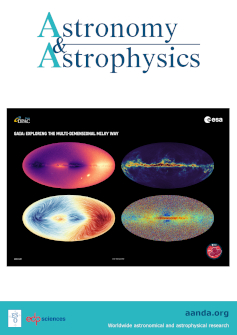DIES: Parallel dust radiative transfer program with the immediate re-emission method
IF 5.4
2区 物理与天体物理
Q1 ASTRONOMY & ASTROPHYSICS
引用次数: 0
Abstract
Context. Radiative transfer (RT) modelling is a necessary tool in the interpretation of observations of the thermal emission of interstellar dust. It is also often part of multi-physics modelling. In this context, the efficiency of radiative transfer calculations is important, even for one-dimensional models.Aims. We investigate the use of the so-called immediate re-emission (IRE) method for fast calculation of one-dimensional spherical cloud models. We wish to determine whether weighting methods similar to those used in traditional Monte Carlo simulations can speed up the estimation of dust temperature.Methods. We present the program DIES, a parallel implementation of the IRE method, which makes it possible to do the calculations also on graphics processing units (GPUs). We tested the program with externally and internally heated cloud models, and examined the potential improvements from the use of different weighted sampling schemes.Results. The execution times of the program compare favourably with previous programs, especially when run on GPUs. On the other hand, weighting schemes produce only limited improvements. In the case of an internal radiation source, the basic IRE method samples the re-emission well, while traditional Monte Carlo requires the use of spatial importance sampling. Some noise reduction could be achieved for externally heated models by weighting the initial photon directions. Only in optically very thin models does weighting – such as the proposed method of forced first interaction – result in noise reduction by a factor of several.Conclusions. The IRE method performs well for both internally and externally heated models, typically without the need for any additional weighting schemes. With run times of the order of one second for our test models, the DIES program is suitable even for larger parameter studies.DIES:采用即时再发射方法的平行尘埃辐射传输程序
背景。辐射传递(RT)建模是解释星际尘埃热辐射观测结果的必要工具。它通常也是多物理场建模的一部分。在这种情况下,即使是一维模型,辐射传递计算的效率也非常重要。我们研究了使用所谓的即时再发射(IRE)方法快速计算一维球形云模型。我们希望确定类似于传统蒙特卡罗模拟中使用的加权方法是否能加快尘埃温度的估算。我们介绍了 DIES 程序,它是 IRE 方法的并行实施方案,可以在图形处理器(GPU)上进行计算。我们用外部和内部加热的云模型对该程序进行了测试,并研究了使用不同加权采样方案可能带来的改进。该程序的执行时间优于之前的程序,尤其是在 GPU 上运行时。另一方面,加权方案只能带来有限的改进。在内部辐射源的情况下,基本的 IRE 方法可以很好地对再辐射进行采样,而传统的蒙特卡罗方法则需要使用空间重要性采样。通过对初始光子方向加权,可以在一定程度上降低外部加热模型的噪声。只有在光学厚度很薄的模型中,加权(如建议的强制首次相互作用方法)才能将噪声降低数倍。IRE 方法在内部和外部加热模型中均表现良好,通常无需任何额外的加权方案。对于我们的测试模型,DIES 程序的运行时间约为一秒,甚至适合较大参数的研究。
本文章由计算机程序翻译,如有差异,请以英文原文为准。
求助全文
约1分钟内获得全文
求助全文
来源期刊

Astronomy & Astrophysics
地学天文-天文与天体物理
CiteScore
10.20
自引率
27.70%
发文量
2105
审稿时长
1-2 weeks
期刊介绍:
Astronomy & Astrophysics is an international Journal that publishes papers on all aspects of astronomy and astrophysics (theoretical, observational, and instrumental) independently of the techniques used to obtain the results.
 求助内容:
求助内容: 应助结果提醒方式:
应助结果提醒方式:


